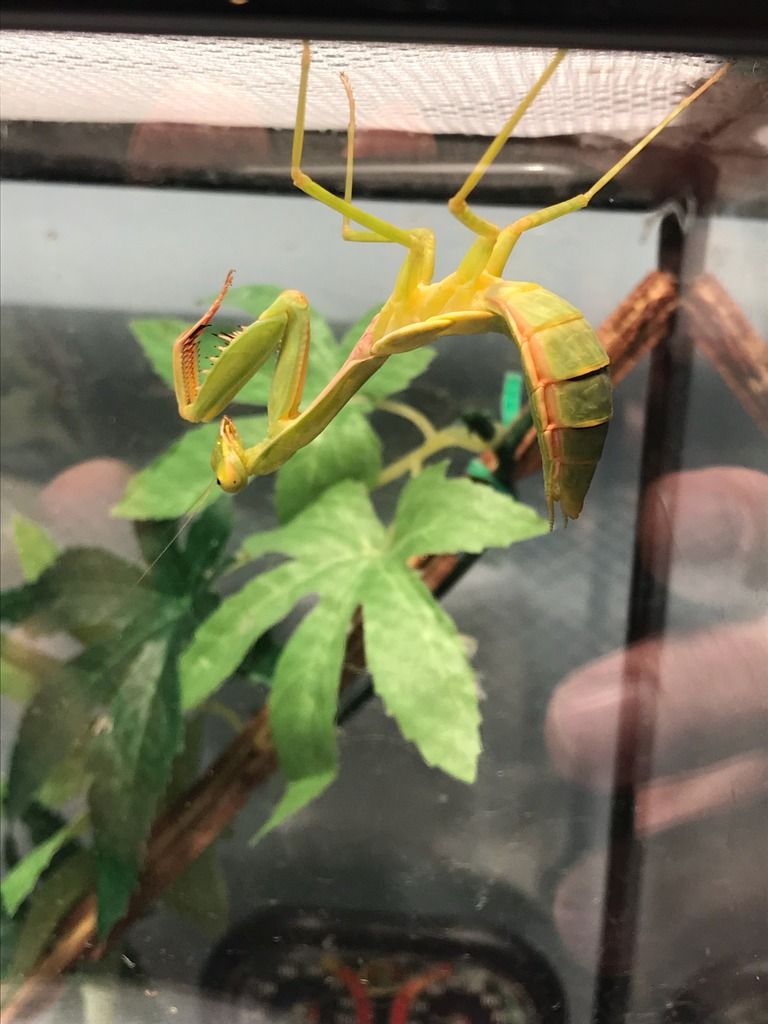You are using an out of date browser. It may not display this or other websites correctly.
You should upgrade or use an alternative browser.
You should upgrade or use an alternative browser.
How to Tell If Your Mantis is Molting
- Thread starter Cole 78
- Start date

Help Support Mantidforum:
This site may earn a commission from merchant affiliate
links, including eBay, Amazon, and others.
Usually, at least as I’ve experienced, they hold an unusual position. They tend to “hang lower” from the ceiling, if that makes any sense. Depending on the breed, sometimes they hang with their bodies almost against the ceiling. Also, when they’re getting ready to molt, ther position their feet in a different way. They just look more attached than they normally do. I’d attach some pictures, but photobucket isn’t working for me right now. I’ll post them when it’s working again.
Another indication is the mantis’s lack of eating. If they ignore food completely, or swing at the flies to scare them away, that’s usually a good sign.
Another indication is the mantis’s lack of eating. If they ignore food completely, or swing at the flies to scare them away, that’s usually a good sign.
bugboymark
Well-known member
ausar318s description is how I would describe it too. Except for really early nymphs stages (where their hunger strike may only last a few hours leading up to a molt), they usually shut down and stop eating for a day or so before hand. A week or longer for the last molt!
A couple other things, just before they molt, all the species I've seen almost always do the following things: They spread all four legs out pretty wide, anchor their tarsi. and they let their whole body sort of relax and hang as low as possible. Their four legs are almost stretched straight. Also, their forelegs also aren't tucked up under their chin and thorax like usual. They sometimes hang down and are partly extended right in front of their face. There are a whole bunch of other behavioral/ physical things that you can observe leading up to a molt. Like changes in skin color, extra skin on the farthest tip of the abdomen, "straining" activity, etc. Regardless, I've attached a picture of a typical pre-molt pose. In this case, an H. venosa. Right before they actually start molting (which takes anywhere between 5 and 20 minutes depending on the size), their body often hangs even lower and their legs are even more straightened out! Once you see it, it'll be easier to recognize. If you see it, it's a good time to leave them alone to avoid a mis-molt. Might even get lucky enough to catch the process in action! Good luck!

A couple other things, just before they molt, all the species I've seen almost always do the following things: They spread all four legs out pretty wide, anchor their tarsi. and they let their whole body sort of relax and hang as low as possible. Their four legs are almost stretched straight. Also, their forelegs also aren't tucked up under their chin and thorax like usual. They sometimes hang down and are partly extended right in front of their face. There are a whole bunch of other behavioral/ physical things that you can observe leading up to a molt. Like changes in skin color, extra skin on the farthest tip of the abdomen, "straining" activity, etc. Regardless, I've attached a picture of a typical pre-molt pose. In this case, an H. venosa. Right before they actually start molting (which takes anywhere between 5 and 20 minutes depending on the size), their body often hangs even lower and their legs are even more straightened out! Once you see it, it'll be easier to recognize. If you see it, it's a good time to leave them alone to avoid a mis-molt. Might even get lucky enough to catch the process in action! Good luck!

Prayingmantisqueen
Well-known member
By their bigger size...bigger appitite..

$18.99 ($2.12 / Ounce)
Josh's Frogs Producing Wingless Drosophila Melanogaster Fruit Fly Culture
Josh's Frogs

$36.00
Carolina Mantis Egg Hatching Kit - 2 Eggs Fresh for The Season
HeZeXinHaoYunWangLuoXiaoShouGongSi

$13.99 ($223.84 / lb)
Surmen Legacy Freshly Started Wingless Drosophila Melanogaster Fruit Fly Culture
Surmen Legacy

$3.19 ($42.53 / lb)
$6.09 ($81.20 / lb)
Fluker's Gourmet Canned Food for Reptiles, Fish, Birds and Small Animals, Black, Mealworms 1.23 Ounce (Pack of 1)
Amazon.com

$12.53
Butterfly Breeding Net, Folding Butterfly Habitat Cage White Butterfly Mesh Cage for Kid Garden Science Education Tool 40x40x60cm
enshishiqiannanwangluoyouxiangongsi

$16.99 ($16.99 / Count)
Josh's Frogs Freshly Started Flightless Drosophila Hydei Fruit Fly Culture
Josh's Frogs

$11.74 ($0.02 / Count)
Predator Foods Bulk Live Mealworms - 500 Count (Medium - 0.5")
Predator Foods

$39.95 ($1.25 / Ounce)
Creation Cultivated 32oz Fruit Fly Culture - Live Feeder Insects for Praying Mantis, Jumping Spiders, Geckos, Lizards, Dart Frogs (Drosophila Hydei Flightless)
Creation Cultivated

$13.99 ($0.44 / Ounce)
$16.99 ($0.53 / Ounce)
Fresh Fruit Fly Culture (Drosophila Hydei) - Praying Mantis Mantid Frog Lizard Food - 32oz Cup
Surmen Legacy

$14.00
$89.85
Praying Mantis Egg Case with Hatching Habitat Cup - 2 Praying Mantids Egg Cases
NaturesGoodGuys
Mantis Lady
Well-known member
Good description how you see they are close to molting.A couple other things, just before they molt, all the species I've seen almost always do the following things: They spread all four legs out pretty wide, anchor their tarsi. and they let their whole body sort of relax and hang as low as possible. Their four legs are almost stretched straight. Also, their forelegs also aren't tucked up under their chin and thorax like usual. They sometimes hang down and are partly extended right in front of their face.
When they start you will see that they are trying to get out of their coat that is too tight. Then it breaks at her or his back. and he/she are wiggling out of it. I always hope to see it.

































